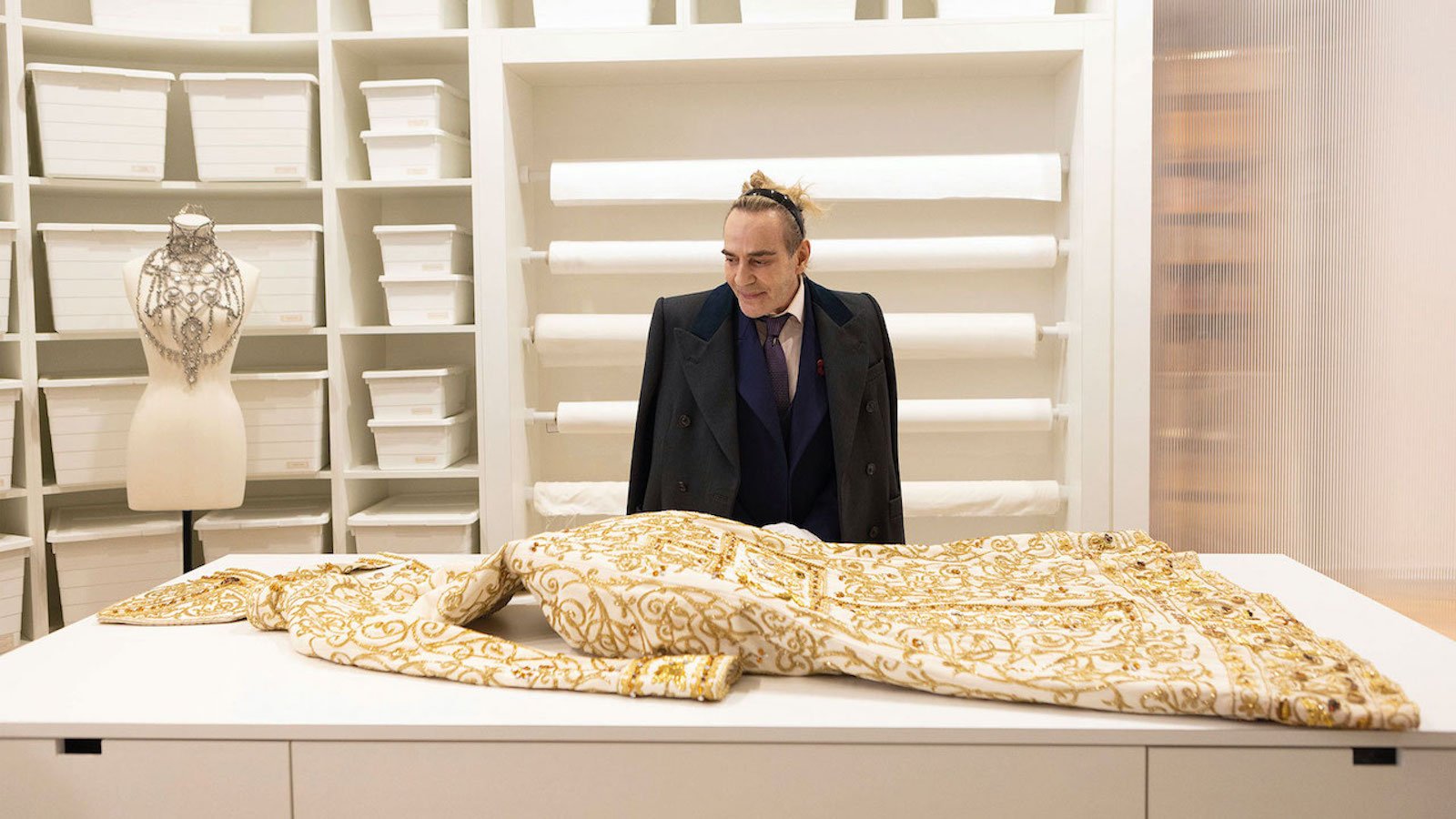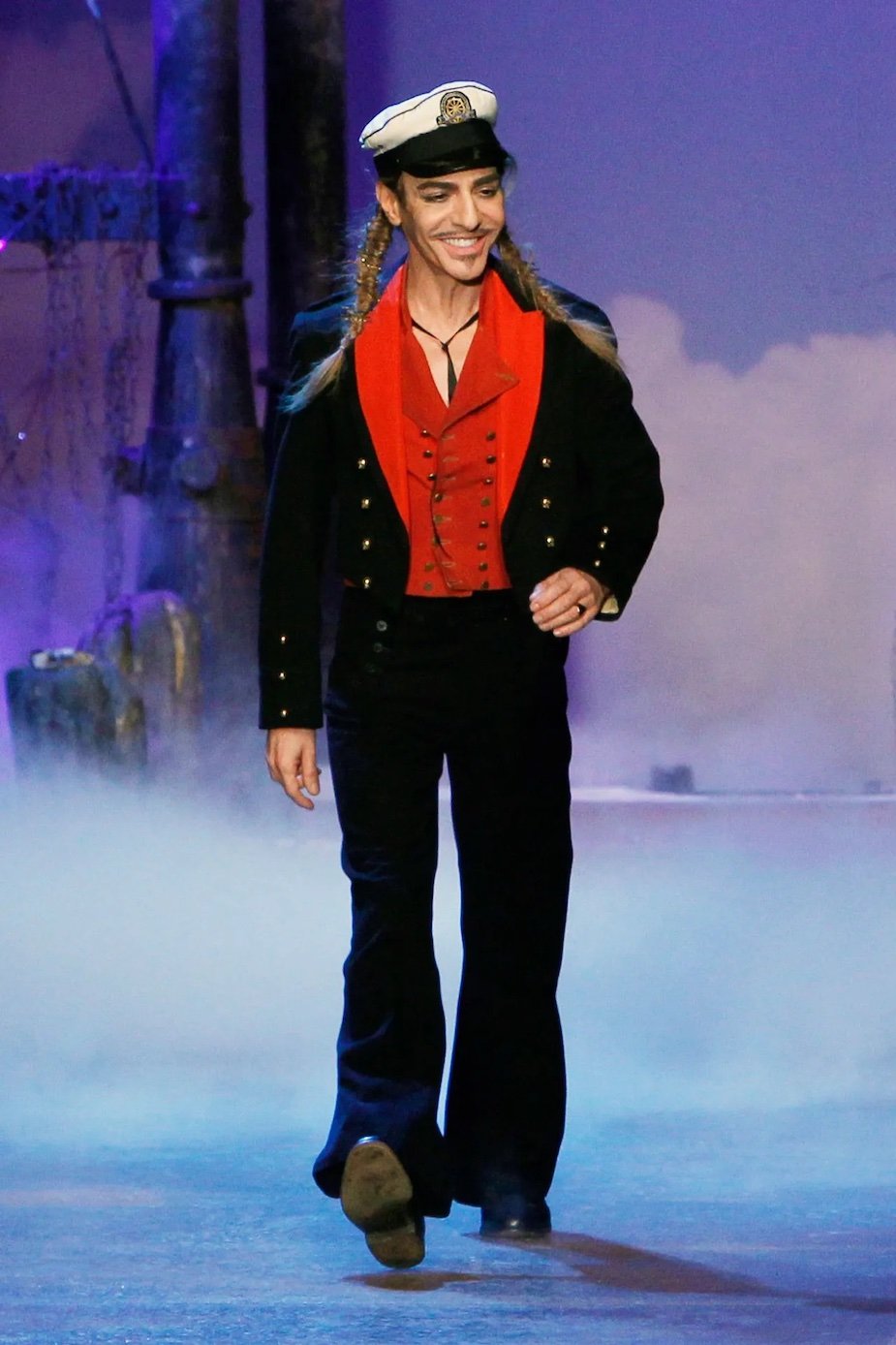There are so many layers to filmmaker Kevin Macdonald’s film that it would take more than a few hundred words to get to them all. At the core of this stunning must-watch documentary is a fashion hero turned antihero who could be a poster child for explaining our current times.
As any good storyteller should, Scottish filmmaker Kevin Macdonald (The Last King of Scotland, The Mauritanian) hides important clues in plain sight throughout his award-worthy 2023 High & Low: John Galliano doc. The film world premiered at Telluride, before moving to European festivals like Zurich and London, where audiences hungry to hear the story of golden child turned foe of political correctness John Galliano made sure the title was sold out.
Some of his clue are straighforward, like American fashion editor and WaPo Pulitzer prize winning journalist Robin Givhan pointing out that Galliano would have never been allowed a comeback, if he hadn’t been a “white male.” Others are as subtle as showing an emotional reunion, a hug between the fashion designer and his favorite seamstress at Dior, a woman named Fatima who wears a black embroidered Palestinian long dress in the shot. During our current challenging times, that emotional moment in the film packs a wallop of a punch in attempting to explain Galliano’s cafe-front tirades.
Galliano’s ‘Bellerophon-ian’ fall from grace came to a climax in February of 2011, after he was filmed by patrons of La Perle cafe in Paris, cursing against the Jews, and fellow cafe customers, in a series of drunken rants. He was soon sacked from the fashion house of Christian Dior, part of the LVMH family of brands, by the maison’s Jewish CEO Sidney Toledano after police were called during the latest incident and Galliano was sued for making anti-semitic remarks — a criminal offense in France.
John Galliano during final bows at Dior, right before his run in at a Paris cafe in the winter of 2011
From his own brand, which Galliano started designing straight out of his graduation line fashion show at Saint Martins College of Art and Design, through his short stint at Givenchy, taking over the role held until then by the maison’s founder Hubert de Givenchy in 1995, to his revitalization of the Christian Dior brand, High & Low follows the seemingly upwards trajectory of this enfant terrible of fashion, along the way attempting to explain the events that caused his incredible downfall.
But Macdonald builds his documentary like an Agatha Christie mystery, giving clues at the beginning of the film — like the fact that Galliano was known by friends and collaborators to crash into a puddle of depression and substance abuse after each collection — which will help explain the events coming later. Don’t blink though, or you’ll miss a single clue which may come in handy at the end.
Never taking sides is another great asset of Macdonald’s direction, something he has managed to do a lot throughout his prolific career as both a documentary filmmaker (see the 2018 doc Whitney) as well as in fiction — in films like The Last King of Scotland, which provided insight into the story of infamous Ugandan dictator Idi Amin through the eyes of a fictional character, the Scottish doctor Nicholas Garrigan. While it is indisputable that Galliano did something, or rather several things wrong, it is also undeniable that he was worked almost to death, designing more than a dozen collections a year for Dior, on top of all the work he was doing to keep his own brand afloat. The premature passing, in 2007, of his close friend and collaborator Steven Robinson, which is highlighted in High & Low, provides clear proof. In court, in the summer of 2011 as he faced charges of anti-semitism, Galliano admitted he had been "pushed to the edge" by financial and emotional pressures.
Perhaps the most important point raised in the documentary, again done by Macdonald on the down low and only if you read (or rather watch) carefully between the lines, is the incredible revolution that John Galliano brought to the fashion industry. This shows in both the scale of the events that showcased his work at the Maison Dior and the media interest that his flamboyant, larger-than-life presentations generated. It is impossible today not to remember those times with a bit of nostalgia for an era that no longer exists, while political correctness and minimalism have taken over the industry. And fashion is replaced by a series of tracksuits worn in different colors, to differing degrees of boring. As the late Karl Lagerfeld said “sweatpants are a sign of defeat. You lost control of your life so you bought some sweatpants,” in a quote first reported by Vogue in 2001.
Kevin Macdonald photographed by © Tim Whitby for Getty Images, courtesy of the BFI London Film Festival
The lusciousness of Galliano’s fashions is only at times eclipsed by the myriad of industry personalities interviewed in High & Low — from supermodels Kate Moss and Naomi Campbell, to Vogue EIC Anna Wintour, Dior’s Toledano and the wonderful Givhan. With a sidebar dedicated to one of the victims of the designer’s cafe-side outbursts, Philippe Virgitti, who seems to have led a sheltered life until coming into contact with Galliano, as he complained of becoming sick as a result of the encounter.
On the other hand, it was surprising to hear Conde Nast Chairman of the Board Jonathan Newhouse basically take credit for the reinstatement of Galliano within the fashion infrastructure, resurfacing at Maison Margiela, which has suited, pardon the pun, the Gibraltar born designer just fine, and has seen him produce some of the brand’s most iconic pieces. While staying true to the elusive and counter-cultural vision of its creator Martin Margiela (about whom little is known, aside from his fashion vision and whose likeness has never been revealed). Just try to get your hands on a pair of the brand’s Tabi Mary Janes for proof of its popularity.
But in the final credits, Conde Nast is listed as one of the film’s producers, so all is well in love and fashion, I guess.
THE BOTTOM LINE: High & Low: John Galliano is a film that deserves to be watched, awarded and rewarded. Fingers crossed that it may not suffer from weak marketing, as shortsightedness could hurt its chances of being submitted to international competitions — favoring instead homegrown UK audience and awards, because Macdonald is Scottish. That would be a shame, for a story that is as universal as our current times are terrifying as well as a visual masterpiece to behold. Hopefully MUBI’s purchase of the film’s rights for distribution and streaming in several markets around the world will help create the buzz this title deserves.
Top image courtesy of the BFI London Film Festival, used with permission.


